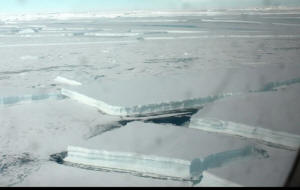|
Giant iceberg like 'niggling tooth' set
to crack off Antarctica
 Send a link to a friend
Send a link to a friend
 [June 21, 2017]
By Alister Doyle [June 21, 2017]
By Alister Doyle
OSLO (Reuters) - One of the biggest
icebergs on record is like a "niggling tooth" about to snap off
Antarctica and will be an extra hazard for ships around the frozen
continent as it breaks up, scientists said on Wednesday.
An area of the Larsen C ice shelf, about as big as the U.S. state of
Delaware or the Indonesian island of Bali, is connected by just 13 km (8
miles) of ice after a crack has crept about 175 kms along the sheet,
with a new jump last month.
"It's keeping us all on tenterhooks," Andrew Fleming, of the British
Antarctic Survey, told Reuters of the lengthening and widening rift,
adding "it feels like a niggling tooth" of a child as it comes loose.
Ice shelves are flat-topped areas of ice floating on the sea at the end
of glaciers. The Larsen C ice is about 200 meters (656 ft) thick with
about 20 meters jutting above the water.

Big icebergs break off Antarctica naturally, meaning scientists are not
linking the rift to man-made climate change. The ice, however, is a part
of the Antarctic peninsula that has warmed fast in recent decades.
"There is no other evidence of change on the ice shelf. This could
simply be a single calving event which will then be followed by
re-growth," Adrian Luckman, a professor at the University of Swansea in
Wales, told Reuters.
His team reckons the ice will break off within months, perhaps in days
or years.
RISKS FOR SHIPPING
The ice, about 5,000 square kilometers (1,930 square miles), will add to
existing risks for ships as it breaks apart and melts. The peninsula is
outside major trade routes but the main destination for cruise ships
visiting from South America.
[to top of second column] |

A view of icebergs remaining after a break-up of Wilkins ice shelf
on the Antarctic Peninsula, January 19, 2009. REUTERS/Alister Doyle

In 2009, more than 150 passengers and crew were evacuated after the
MTV Explorer sank after striking an iceberg off the Antarctic
peninsula.
Fleming said the Larsen C iceberg would add an extra pulse of ice
and would be hazardous especially if smaller chunks reached usually
ice-free areas in the South Atlantic, rather than staying close to
Antarctica's coast.
The Larsen B ice shelf nearby broke up in 2002 and some of the ice
drifted into the South Atlantic toward the island of South Georgia,
east of Argentina.
In 2000, the biggest iceberg recorded broke off the Ross ice shelf
and was about the size of Jamaica at 11,000 square kms. Bits have
lingered for years.
The loss of ice shelves does not in itself affect sea levels because
the ice is already floating. But their disappearance lets glaciers
on land slip faster toward the ocean, thereby raising sea levels.
NASA estimates that the Larsen C ice shelf pins back ice on land
that would add a centimeter (0.4 inch) to world sea levels, which
have gained about 20 centimeters in the past century.
(Reporting By Alister Doyle; Editing by Gareth Jones)
[© 2017 Thomson Reuters. All rights
reserved.]
Copyright 2017 Reuters. All rights reserved. This material may not be published,
broadcast, rewritten or redistributed.
 |